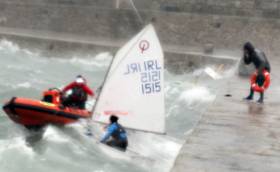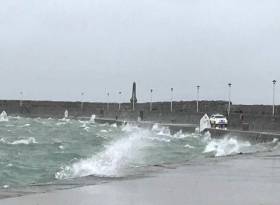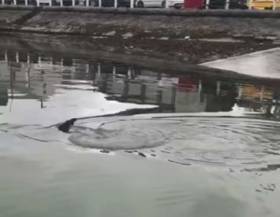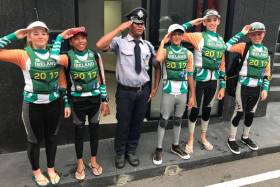Displaying items by tag: Optimist
Dun Laoghaire Optimist Training Incident – The Young People Must Be Our First Priority
W M Nixon on the aftermath of Saturday's Optimist dinghy training incident during Storm Brian.
“A boat, by God, it’s just a gleamin’ beautiful creation. And when you pull the sail up on a boat, you’ve got a little bit of somethin’ God-given. Man, it goes bleetin’ off like a bird wing, you know, and there’s nothin’ else like it.”
The speaker was Clark Mills of Clearwater, Florida, who very rightly was recently inducted posthumously into American Sailing’s Hall of Fame. In 1947, Clark Mills developed the design of the Optimist dinghy for the kids of his community in response to a request from two public-spirited citizens, who reckoned that a hyper-economical little sailing boat would encourage children to interact positively with the warm and wonderful sailing waters of their sun-blessed neighbourhood.
Clark Mills was an ingenious back-street boatbuilder whose seemingly unassuming design was so clever that three Optimists could be built out of four sheets of standard 8ft x 4ft marine plywood. But it remained a localized way of making sailing accessible until a Scandinavian sail training ship was in port, and the captain was very impressed with these little sailing prams.
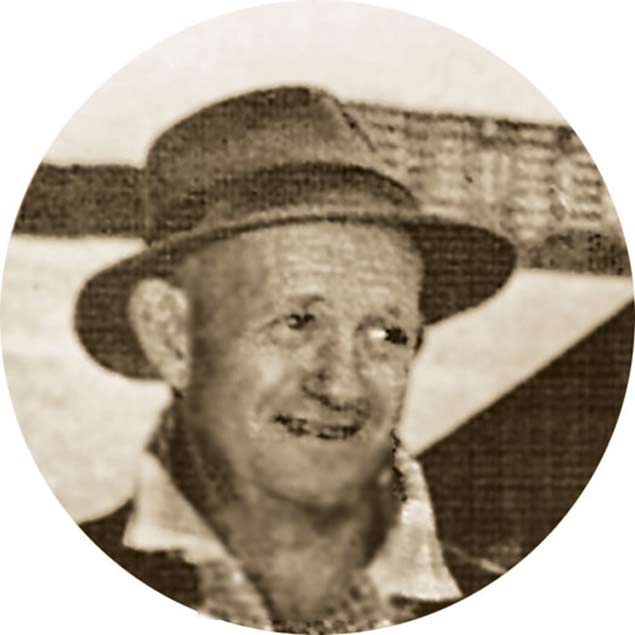 Clark Mills (1915-2001) designer and first builder of the Optimist Dinghy in 1947, has recently been posthumously inducted into American Sailing’s Hall of Fame
Clark Mills (1915-2001) designer and first builder of the Optimist Dinghy in 1947, has recently been posthumously inducted into American Sailing’s Hall of Fame
So he took one of them on board his tall ship, and brought her home to Sweden, and that was the end of the Age of Innocence for the Optimist dinghy. Once the Scandinavians had decided that these wonderful little boxes were the future of sailing for their young children despite their own tradition of very elegant sailing craft, the Optimist dinghy went global, and now more than 300,000 have been built.
It’s far indeed from the balmy sandy islands of Clearwater to the old granite pond of Dun Laoghaire on a late October Saturday, when the cream of Irish Optimist sailing – sixteen young helms from all over Ireland and their rather expensive boats - have been assembled on a long-planned, intensive and costly training session with a coach who is renowned for his ability to empathise with the junior sailors, and greatly improve their performance.
The pressure is on for busy instructive sailing, but the pressure meteorologically speaking is through the floor, as the centre of Storm Brian approaches Dublin Bay in textbook style. It’s so pure textbook that a patch of blue sky actually appears. But there’s a nice breeze, and the kids are sent out sailing because, after all, they’re in a harbour which is a giant pond, and if the weather does deteriorate, the pond provides shelter and security.
But within 25 minutes, the weather goes beyond deterioration. It falls off a cliff. Classic style again, the centre of the low has moved to the northeast: “Sharp rise after low, foretells a stronger blow”. The sudden west to northwest wind was over 40 knots, with a highest recorded gust in Dun Laoghaire of 51 knots, and that with dense air to increase the pressure even further.
Close in against the East Pier, the harbour becomes a boiling cauldron of backwash with completely unsailable conditions, and the four Optimists near it are jammed against the wall. But as it’s high water it’s possible to haul their young skippers ashore. The rest of the fleet managed to return to base, and all are well scared, but are soon recovering as kids do.
Or at least that’s how they show it, for these after all are the elite squad, and there’s peer pressure. Either way, it has to be clearly asserted that the outcome of all the continuing deliberations on this incident should place the effect it has had and is having on the kids first, middle, and last.
They’re a remarkably mature bunch of young people for their age, but the organisation of society is such that all responsibility in a situation like this ultimately falls on adults, and we as a sailing community will be judged on how this is worked out in the days, weeks and months ahead.
Inevitably, officialdom will have to move at its own ponderous pace, but meanwhile the kids, the parents and the Optimist sailing world in Ireland are moving at their own different paces to take the experience in board, while getting on with life at the same time.
Talking to a parent who had two kids rescued from the East Pier, he says their resilience is a wonder to behold. One is already sailing again in a team racing series, and the other is keenly anticipating another Optimist training session this weekend. As for sailing’s real community, the local rather than the official, they have been quietly doing good work by stealth – the only true good work – by lending replacement boats for those whose craft have been damaged or wrecked, in order that the programme can continue with just this one interruption.
On the business side, the parent to whom we talked felt much more sanguine about a satisfactory insurance settlement than he had at the beginning of the week. And even though all the parents are still in something of a state of shock, the needs and expectations of the keen kids are encouraging them to move on and be positive.
For outsiders, all this may sound almost too good to be true. But anyone who has been even on the edge of the Optimist world will know that it’s one very extraordinary place. It’s not for everyone by any means. But for those for whom it clicks, it’s a miraculous and marvellous experience.
So as we see the wheels of officialdom begin to turn, with positions being taken up as various organisations seek to protect their image and their good standing, is it too much to ask that the top people remember to take on board the opinions of the kids involved every bit as much as they take into consideration the storm of criticism which has spread across social media?
Teaching and coaching are very special talents. But just because you’re very good at helping young people to sail even faster, that doesn’t necessarily mean that you can make sage judgments about future weather and the organisation of events. In fact, shared enthusiasm across the generations about improved performance can be a potent force for clouding judgment. That seems to have happened here. We’re not trying to make excuses. We’re just trying to explain how something happened.
So as people sound off about the need “to make heads roll”, how about quietly asking the 16 kids involved what they think?
That surely is what Clark Mills would have done.
Optimist Team Had 'Weather Window Providing Reasonable Conditions for Such Activity' – Irish Sailing Statement
Irish Sailing, the national governing body for the sport in Ireland, has issued a statement following the rescue of its 16-boat National Optimist Squad during Storm Brian on Saturday lunchtime in Dun Laoghaire Harbour. In the statement, released yesterday, the association says 'all usual risk assessments were undertaken before launching and the forecast was for a weather window providing reasonable conditions for such activity'.
Irish Sailing also says it is 'now investigating what protocols and assessments may need to be reviewed and/or revised so that we maintain all safety standards'. Read the full statement below.
The rescue, reported by Afloat.ie here, involved local yacht club RIBs, Dun Laoghaire Coast Guard and RNLI inshore boats. The incident was widely reported in the weekend media and attracted significant social media comment. Joe Mag Raollaigh of RTE News captured video of one of the Oppy dinghies being wrecked against the harbour wall as north-westerly winds reached over 40–knots.
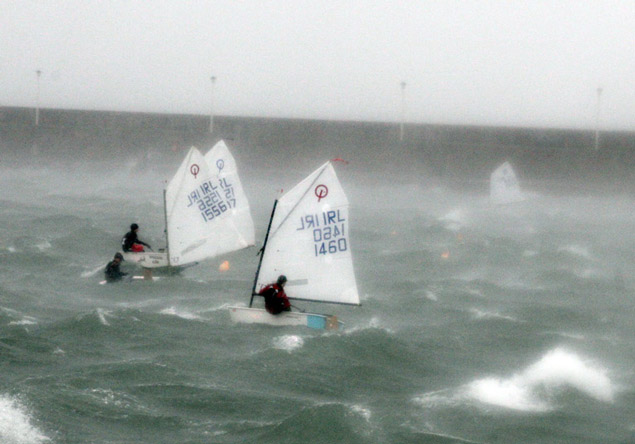 Big breeze for training in Dun Laoghaire Harbour. Photo: Stephen Collins of Collins Picture Agency
Big breeze for training in Dun Laoghaire Harbour. Photo: Stephen Collins of Collins Picture Agency
Dangerous situation in @dunlaoghaire harbour averted after sailors rescued from small boats overcome by wind & waves #stormbrian #rtenews pic.twitter.com/sKN0rTT2HL
— Joe Mag Raollaigh (@joemagraollaigh) October 21, 2017
Stephen Collins of Collins Picture Agency captured some dramatic pictures of the training session and the rescue and these appeared on Dublin Live here and the Irish Times. The Irish Independent ran a story here.
The ISA Statement reads:
UPDATE ON OPTIMISTS IN DUN LAOGHAIRE YESTERDAY
'Sixteen Optimists were launched yesterday morning (Saturday 21 October) inside Dun Laoghaire Harbour as part of a routine high-performance training programme, along with the safety boats which are present at all training events. All usual risk assessments were undertaken before launching and the forecast was for a weather window providing reasonable conditions for such activity. A squall came in and the decision was made to send the sailors to shore immediately. The Dun Laoghaire Coast Guard and RNLI inshore boats were launched as a precaution but at that stage all the sailors were onshore. No sailor was harmed.
In circumstances like this, there are tried and tested protocols that come into effect with all bodies working together for a safe outcome. The safety of the sailors was prioritised over equipment. We are now investigating what protocols and assessments may need to be reviewed and/or revised so that we maintain all safety standards'
Following the rescue a number of the children's dinghies were left abandoned overnight in the harbour then picked up the following morning.
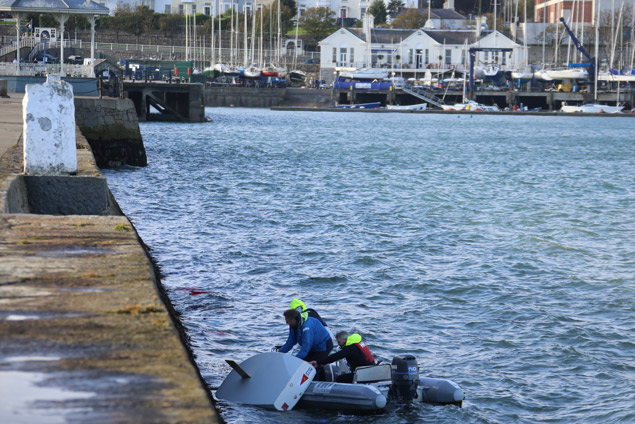 A Royal Cork Optimist dinghy is recovered into a RIB off the East Pier at Dun Laoghaire on Sunday
A Royal Cork Optimist dinghy is recovered into a RIB off the East Pier at Dun Laoghaire on Sunday
Storm Brian Hits Dun Laoghaire: Optimist Dinghies & Sailing Cruiser End Up On Harbour Walls
Storm Brian's strong north–westerly winds, gusting over 40–knots, left both a training group of Optimist sailors and at least one moored cruiser on Dun Laoghaire harbour wall this lunch time.
Eyewitness reports say that four Optimist dinghies were 'abandoned' in the squall at the East Pier. The eyewitnesses say the junior sailors involved are safe and accounted for.
Dangerous situation in @dunlaoghaire harbour averted after sailors rescued from small boats overcome by wind & waves #stormbrian #rtenews pic.twitter.com/sKN0rTT2HL
— Joe Mag Raollaigh (@joemagraollaigh) October 21, 2017
In a separate incident, in what appears to be case of broken ground tackle, a sailing cruiser ended up on the West Pier earlier this morning.
 A launch attends to a sailing cruiser lying up against the West Pier wall at Dun Laoghaire
A launch attends to a sailing cruiser lying up against the West Pier wall at Dun Laoghaire
Water Temp:13.8 °C, Avg Wind:29kts, Gust:42kts, Wind Dir:290 °(W), Gust Dir:302 °(NW), Wave Height:0.9m at 21/10/2017 14:29:00
— Dublin Bay Buoy (@DublinBayBuoy) October 21, 2017
The incidents have prompted a statement regarding today's on the water activities from the Irish National Sailing & Powerboat School Chief Instructor & Director, Kenneth Rumball:
'The Irish National Sailing & Powerboat School cancelled most of it on the water activities due to the adverse weather forecast for Saturday the 21st October 2017.
We had a small number of our brightly colored craft on the water for a very short period of time on Saturday morning.
A small number of powerboat clients were operating in a very well sheltered area of the inner harbour for a time also this morning.
Knowing the weather was due to hit later that morning, all clients, staff and personnel were off the water once the worst of the westerly winds started to hit.
None of the craft in the videos and pictures circulating the internet from Dun Laoghaire Harbour are craft belonging to the Irish National Sailing & Powerboat School'.
The centre of #StormBrian is now over Dublin pic.twitter.com/hj3L6SMgwU
— Met Éireann (@MetEireann) October 21, 2017
Update here.
Sailing Coach Spots 'Shark' in Skerries Harbour, County Dublin (VIDEO)
Sailing instructor Kerri-Ann Boylan was out coaching kids in Optimist sailing dinghies at the weekend when she spotted a fin in the water in Skerries Harbour in North County Dublin.
'As I brought the kids into land and about to let them jump out of my boat we spotted a fin', she wrote on social media on October 10th.
'It's a very rare sight of a 'shark' being in that close to land and in the Irish Sea,' she added.
Optimist Leinsters a Great Success for National Yacht Club Despite the Weather
It was a clean sweep for Royal Cork Yacht Club junior sailors at the Optimist Leinster Dinghy Championships at the National Yacht Club last weekend.
Justin Lucas won the Merrion Private sponsored event where 139–sailors registered including 29 from the host club.
Lucas's clubmates Harry Twomey and Harry Pritchard finished second and third respectively.
There were very challenging windy conditions, as Afloat.ie reported here, over the entire weekend and despite this five races took place over both days.
Race Officer for the main fleet was Con Murphy and Paddy Judge officiated for the regatta fleet.
Results are here
Geraghty-McDonnell Leads Optimist Leinsters at National Yacht Club
Recently crowned Irish Optimist champion Rian Geraghty-McDonnell (14) of the National Yacht Club leads a blustery Leinster Championships hosted by his own club on Dublin Bay.
Four points behind, Royal Cork's Harry Twomey is second on seven, with Geraghty–McDonnell's club mate Nathan van Steenberge third on eight points in the 42–boat senior fleet.
Two races have been sailed in the relative shelter of Scotsman's Bay in blustery, north-westerly breezes reaching 20–knots and more at times but a third race was bandoned due to building winds in the late afternoon.
Racing continues tomorrow.
Full results for all three divisions are here
Rian Geraghty-McDonnell has won the Irish Optimist National and Open Senior Championship and Luke Turvey the Junior Optimist National and Open Championship at the IODAI championships hosted by the Royal Irish Yacht Club.
With a full series of 10 races sailed over the four–day event on Dublin Bay, everything came down to the last race to decide who was going to win the titles. Geraghty-McDonnell got a black flag in the second last race but showed real depth of character to come back in the last race and take the title with Justin Lucan of Royal Cork Yacht Club finishing one point behind.
The following results concluded the top ten senior sailors, Leah Rickard 3rd, Rory O’Sullivan 4th, Harry Twomey 5th, Emily Riordan 6th, Harry Prtichard 7th, Hugh Turvey 8th, Moss Simington 9th and Conor Gorman 10th.
Luke Turvey of HYC/NYC won the Irish Optimist National and Open Junior Championship. The Junior series mirrored the seniors and also came down to the wire with the last race deciding the title. Luke Turvey beat HYC club mate Johnny Flynn by one point to take the Junior title.
Oisin Kelly won the title in Regatta fleet, followed by Tristan Farrer from GBR in second place and in third place was Harvey Matthews from KYC.
The IODAI say it was one of the most competitive Irish Nationals ever with an amazing display of sailing talent by Ireland's young and up and coming sailors.
Next year's National Championships are heading for Kinsale in County Cork.
Howth Yacht Club's Hugh Turvey has taken an early lead at the Optimist National Championships on Dublin Bay.
The fourteen–year–old has worked out a decent margin in light winds after only two races sailed at the Royal Irish Yacht Club. Turvey counts a first and a second to be six points clear of two Royal Cork Yacht Club entries tied on nine points where Michael Crosbie leads Harry Pritchard. Another RCYC sailor, Harry Twomey, lies fourth on 11–points. The National Yacht Club's Conor Gorman on 14 points rounds out the top five of the 65–boat main fleet.
74 sailors are competing in the Junior fleet and just under 50 sailors in the regatta fleet. Full results are here.
Racing continues tomorrow.
Irish Optimist Team Depart for Euro Champs in Bulgaria
The Irish Optimist Sailing team are on their way to Burgas, Bulgaria to take part in the European Championships.
Two hundred and fifty sailors will participate in the week-long event with ten races expected from 30th July to 5th August.
The Irish team members pictured above are (from left to right) Ruth McSweeney, team Manager, Cillian Foster (RCYC) Johnny Flynn (HYC and RstGYC) Conor Gorman (NYC), Luke Turvey (HYC and NYC)) Emily Riordan (RstGYC) Kitty Flanagan(RstGYC) and Iseult Hogan(RstGYC).
Irish Optimists Ninth in Team Racing Worlds
After a fine display of Team Racing by the Irish Optimist Team in Thailand, Ireland had a spectacular win over France to finish ninth overall in the Team Racing World Championships 2017.
Things were looking good for Team Ireland when they got into final 16 of the World Championships from 62 countries.
Following three days of fleet racing Ireland was seeded 40th out of 48 teams that qualified for the Team Racing World Championships.
The Irish team comprised Justin Lucas, Harry Twomey, Leah Rickard, Alana Coakley and Charlie Cullen.
After a long day on the water at Royal Varuna Yacht Club, Team Ireland, under Captain Harry Twomey secured a place in the final 16. An amazing achievement, for an Irish Team to qualify for the second round in the Team Racing World Championships.



























